Every aquarium has its own ecosystem, which can make it tricky to deal with algae blooms and get them under control.
But, don’t worry, there are some steps you can take to ensure algae is kept under-control in your aquarium,
In this article, I’ll share with you my personal experience and proven methods on how to identify, treat, and get algae under control in your aquarium.
Table of Contents
1. Black Beard Algae (Audouinella/Black Brush Algae/BBA)
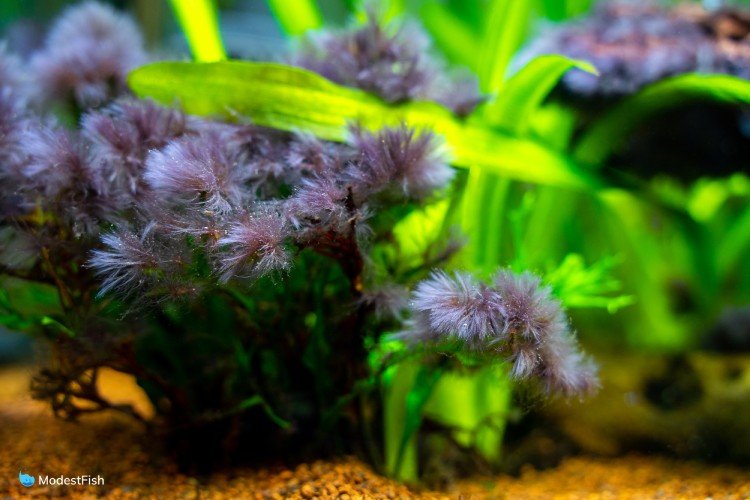
A type of red algae (Rhodophyta), BBA is more common in saltwater setups, but can also appear in freshwater tanks.
Black Beard Algae feeds through photosynthesis. So, it thrives in bright light.
Soft, slippery, and hard to remove, BBA will grow quickly in dense patches (looks like a patchy beard) on slow growing plants, bogwood, driftwood, and any hard surface in your tank.
Common Causes of Black Beard Algae
Low or unstable CO2 conditions and too much light tends to be the main culprit.
This stuff really loves high lighting. It soaks up light like Superman, and can be just as hard to defeat.
Water flow is another cause which has been debated online.
However, from my own experience, high water flow does not deter BBA. I’ve seen BBA growing in high and low-flow areas. I’ve seen this algae, grow directly on the outflow pipe of a powerful canister filter. I’m fairly sure that it can grow pretty much anywhere it wants, when it comes to flow.
As long as it has plenty of light, this algae can grow wherever it wants.
How to Get Rid of Black Beard Algae
I do not recommend trying to manually remove black beard algae.
If you try to scrape off BBA, tiny pieces of it will break off and spread all over the tank. So, you might scrape it off one area, but it will start to pop up everywhere else.
The best way to eliminate BBA in your aquarium is to cut off your lights.
This species thrives on high lighting. Blacking out the tank, for up to two weeks, is the most effective way to get rid of large areas of BBA.
Anything that can be taken out of the tank to be cleaned, should be removed and thoroughly scrubbed with hydrogen peroxide.
From there, you can start to administer spot treatments in the display tank.
Your best bet for spot treatment is Seachem Flourish Excel.

Last update on 2024-04-17 / Commissions Earned / Images from Amazon Product Advertising API
Use an eye dropper or pipette to drip Excel directly onto the leaves of plants. You can do this, even if the plants are underwater. You just need to make sure to turn off filters and powerheads so the water is very still.
Putting the Excel directly on the algae is much, much more effective than just dumping the entire dose of Excel into the water column.
A day or so after putting the Excel on the algae, you’ll see it start to turn orange, signifying that it has died. It should break down a few days after turning orange.
Make sure to follow the daily dosing recommendations listed on the bottle. Don’t ever overdose Seachem Excel.
You can also use hydrogen peroxide as a spot treatment on very hardy plants. Just be aware, some softer plants don’t do well with the direct application of peroxide. Hydrogen peroxide is a powerful oxidizer, and will cause delicate plants to turn brown and lose their leaves.
Try putting the peroxide on a single leaf first, and then give it a few days to see whether or not there is any damage.
Don’t exceed 2 mL of peroxide per gallon of aquarium water per day.
What I like to do is treat the tank right before my weekly water change. I turn off all of the water flow in the tank, treat the plants with hydrogen peroxide, and then drain and refill the tank for my normal water change. This minimizes the amount of peroxide in the tank for the livestock in the tank, but serves as a good spot treatment on all the plants I drip peroxide onto.
You can also try testing the dissolved CO2 levels in your aquarium. If they’re low, increase the amount of CO2 as it will stimulate your plant’s growth, helping them to out-compete the algae for resources.
Black Beard Algae Eaters
Not many creatures are willing or able to eat BBA. Apparently it is quite tough and tastes gross.
- Amano Shrimp
- American Flag Fish
2. Blanket Weed (Cladophora sp.)
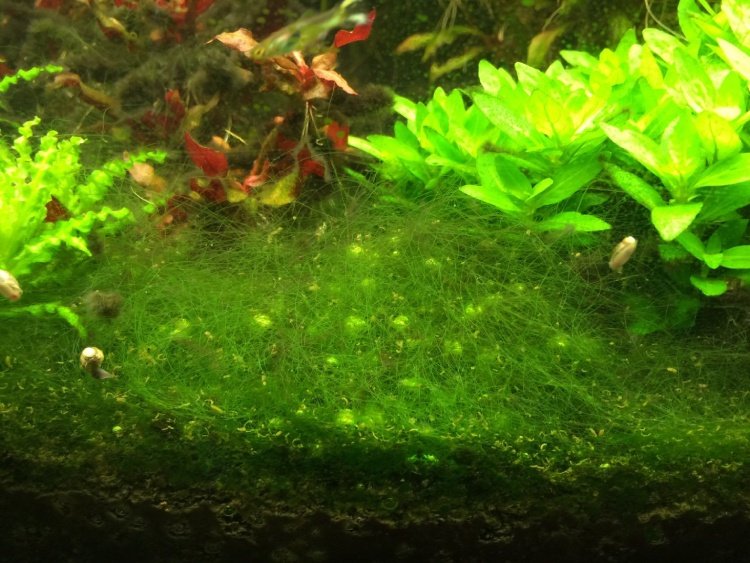
Arguably the toughest algae to remove – I feel for you if you’ve got it.
It looks just like it sounds: a thick, tough, green, wool-like blanket of algae, that can attach itself to plants, substrate, and hardscape items.
On top of all that, if you rub or crush Blanket Weed, it will emit a nasty pungent smell.
Yuck.
Common Causes of Blanket Weed
It’s often introduced to the aquarium on live plants. It frequently hitches a ride on Marimo Balls that are from the same algae family. The moss ball can be covered in a light dusting of blanket weed, and no one would be the wiser.
This algae can be very problematic in a high tech planted tank because it can grow rapidly if you have high levels of nitrates, CO2, and light.
Unfortunately, Blanket Weed favors the same water conditions as plants.
How to Get Rid of Blanket Weed
Turn off the current in your aquarium to avoid small pieces Blanket Weed from breaking off while you’re cleaning it and establishing new populations elsewhere in the tank.
Remove large chunks of the Blanket Weed, and suck them up with your gravel vacuum, to make sure that it doesn’t spread.
You can then use Excel with a syringe to spot treat problem areas.
It can be a lengthy and arduous process to get Blanket Weed under control. You may need to continue doing weekly spot treatments for quite some time.
The algae has to be held at bay so that plants can utilize the light and nutrients and start to outcompete the Blanket Weed for food/light. I would highly recommend adding some Amano shrimp to graze on the Blanket Weed and keep it trimmed back.
It’s hard to remove Blanket Weed, so the best course of action would be to not introduce it in the first place
Be very picky about which plants you introduce and where you buy them from – always quarantine new plants for a few weeks before adding them to your aquarium.
Blanket Weed Algae Eaters
- Amano Shrimp
3. Blue-Green Algae (Cyanobacteria)
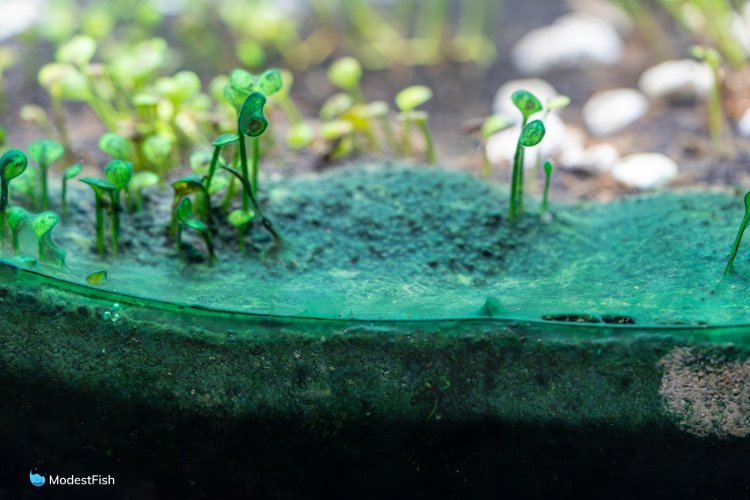
This isn’t a true algae; it’s an aquatic cyanobacterium which is able to photosynthesize.
It’s also a nitrogen-fixing bacteria, meaning it also feeds on nitrate. It’s possible for the.BGA two outcompete your plants for nitrate in the water column.
It’s fast-growing, covering everything in a blue, green, reddish purple, or brown slimy mat and has an interesting earthy smell when taken out of the aquarium.
It’s common to find it on your substrate and along the front of your aquarium glass where it receives the most light.
Common Causes of Blue-Green Algae
There are usually several problems in the aquarium that intersect and cause BGA outbreaks.
High levels of organic waste from overfeeding and/or a lack of water changes are major contributors to BGA blooms.
The Blue-Green algae will gladly gobble up these wastes, it’s like a steak dinner for BGA.
Subjecting your aquarium to too much light for too long is the biggest factor in BGA outbreaks.
Or old light bulbs which are no longer emitting the correct light for your plants can result in your plants no longer being able to outcompete the BGA.
It’s common for BGA to appear in the wild where there’s low water circulation. Poor water circulation in your tank lets BGA gather into piles along the substrate, instead of getting stirred up and sucked into the filter.
How to Get Rid of Blue-Green Algae
There are a few ways you can attempt to combat Blue-Green algae.
- Control your lighting – put your lights on a timer. I recommend that you only keep your lights on for 8 hours a day while you’re trying to remove algae. You can always try bumping up the time later once things are more under control.
- Increase aquarium maintenance – perform 50% water changes weekly and make sure to thoroughly gravel vacuum the substrate to get rid of any BGA along the bottom.
- Increase water flow – if water is flowing along the substrate, the cyanobacteria will not be able to gather and spread. You can add on powerheads, air stones, or better yet, a Sponge Filter, to keep the bottom stirred up so the BGA gets sucked up by the filtration system.
- Antibiotics – you will sometimes see people online recommend using medication to kill Blue– Green algae. It is true that the antibiotics in Maracyn can kill BGA. However, I do not recommend using this method. It says right on the packaging that this product can negatively affect the beneficial bacteria in your filter.
- Fast growing plants – can help fight BGA; they can kill the algae off by out-competing them for nutrients.
- Seachem Excel – use an eyedropper or dosing syringe to treat problem areas with an Excel treatment, and then manually remove the dead algae.
- Filter cleaning – clean out filters to get rid of built up mulm.
Blue-Green Algae Eaters
- None known (if you have any information, please share)
4. Brown Algae (Diatoms)
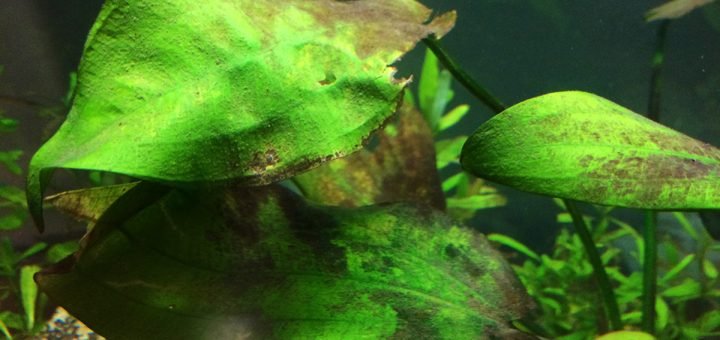
A form of Diatom, it’s able to obtain nutrients through photosynthesis and chemicals (silicate, phosphorus and nitrates). Meaning it’s able to survive in low light conditions if their chemical food is available.
Found in freshwater and marine aquariums, Brown algae will start out as a dusting on the substrate in your tank.
Then in approximately 5 days, it can turn into a slimy film covering your tank’s glass, substrate and plants – it doesn’t look great.
Common Causes of Brown Algae
It’s common for Brown algae to appear in new aquariums during the nitrogen cycle.
It’s actually a good sign. It means the tank is starting to mature and become a little ecosystem.
How to Get Rid of Brown Algae
Brown algae usually goes away on its own as your tank matures.
But in the meantime, if it’s driving you nuts, it’s quite easy to manually remove brown algae.
Decor can be taken out of the tank and wiped down with a clean scrubbing pad (the super cheap plain kind that doesn’t have any added cleansers).
You can usually just rub diatoms off of plant leaves with your fingers.
Use an algae scraper to get brown algae off your glass.
Related: Best Algae Scraper
Best Brown Algae Eaters
5. Fuzz Algae
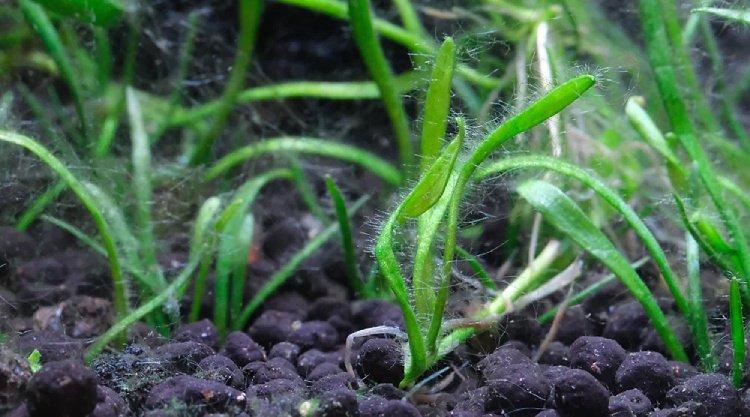
The name says it all: it’s a short green algae which grows on your plants, decorations, and glass, creating a soft, fuzzy green layer over everything.
The community is unsure if Fuzz algae are an early growth stage of Hair algae.
Like most algae, it’s not a problem to have a small population in your tank.
Common Cause of Fuzz Algae
Fuzz algae loves high light and high nutrients.
How to get rid of Fuzz Algae
This is another species of algae where controlling the light is a key factor to keeping it at bay.
Cut the lights for a few days and then put them on a timer to reduce the photoperiod.
I also highly recommend bringing in an algae cleanup crew that will keep the fuzz grazed down.
Fuzz Algae Eaters
- Amano Shrimp
- Otocinclus
- Black Mollies
- Bristlenose Plecos
- American Flag Fish
6. Green Aquarium Water Algae
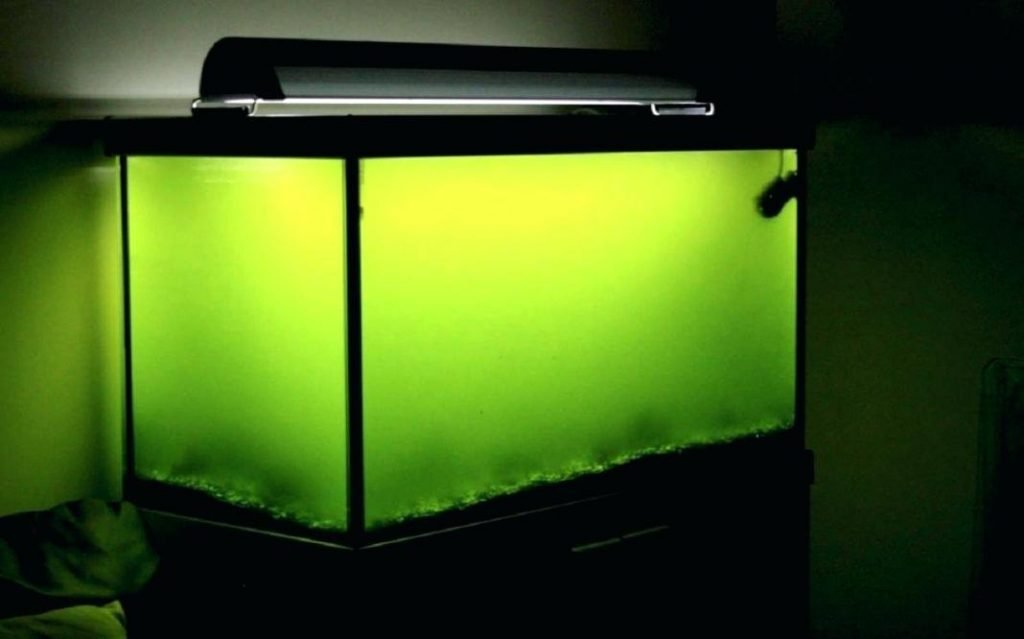
Hated amongst the aquatic community, it will appear in freshwater tanks, turning them pea-soup green. It may look awful, it’s not toxic to your fish.
It appears after a bloom of unicellular algae which obtain their energy and growth through photosynthesis.
These little single cell algae float around in the water column instead of attaching themselves to surfaces, like other species do. As their population grows in size, they start to make the water darker and darker green.
Common Causes of Green Water Algae
Too much lighting is the primary cause of Green Water Algae. An overabundance of nutrients can help cause Green Water, but it can’t make your water look like pea-soup without the energy from strong lighting.
How to get rid of Green Water Algae
Once again, controlling the light in your tank is how you control Green Water Algae.
Black out the tank for about a week, and put the lights on a timer after that.
In the meantime, perform 50% water changes every 3 days. All that floating algae will be dying off from lack of light and it’s best to remove it.
Green Water Algae Eaters
Because Green Water Algae floats around in the water column, most conventional algae eaters can’t eat it.
- Daphnia – tiny, free-swimming crustaceans. They’re a great food source for fish.
7. Green Dust Algae (GDA)

Green Dust algae forms a thin coating of a soft slime that grows in irregular patches along all the surfaces of the tank, even the glass.
It’s easy to mistake GDA for Green Spot Algae (GSA) visually, since both are a bright green coating that covers everything.
But, it’s easy to tell them apart by touch. Green Dust Algae is very soft. You can easily scrape it off with your fingers.
Green Spot Algae is very hard and tough. It makes the glass feel like it has a rough bumpy texture. GSA does not rub off when you try to scrape it with your fingers. It can even be difficult to get off, even with an algae scraper.
Common Causes of Green Dust Algae
GSA feeds on high lighting. Once again, high nutrients will help this algae grow faster, but GSA can pop up even in well maintained tanks.
How to Get Rid of Green Dust Algae
Get control of the lighting in your tank by putting everything on a timer.
Manually remove as much of the GSA as possible. As part of your weekly water change, remove and clean decor and scrape your glass.
Remove water from the tank after you scrape the glass so that you remove as much of the scraped off algae as possible.
Green Dust Algae Eaters
- Bristlenose Plecos
- Otocinclus catfish
- Snails
- Amano shrimp
- Cherry shrimp
8. Green Spot Algae (GSA/Coleochaete Orbicularis)
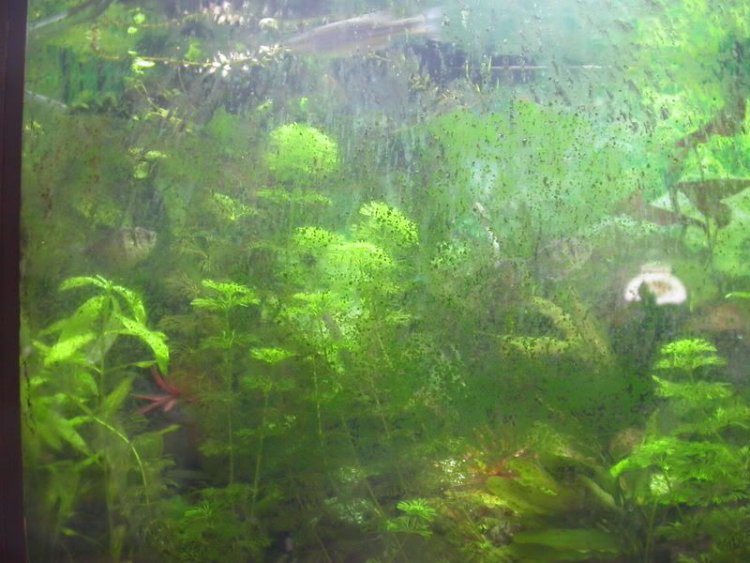
Appearing as hard green tiny spots on your glass, equipment, decorations, and slow growing plants.
It’ll start out as a few tiny dots, but as time goes by, more and more dots show up until they completely coat surfaces.
It’s easy to tell Green Spot Algae from other kinds of green algae. If you try to rub it off with your fingers, and it doesn’t easily come off, it’s Green Spot Algae.
Common Causes of Green Spot Algae
Green spot algae thrives on high light. I’ve seen it grow in both nutrient rich or nutrient poor environments.
It will thickly coat areas of the tank that get bright light and recede completely from shaded areas.
I’ve seen lots of sources make claims about GSA being caused by low or high phosphates. I have never found this to be true.
I’ve had it grow just fine in tanks that were dosed with lots of phosphate, tanks that had no phosphate added at all and everything in between.
So, I don’t buy into the idea that you’re going to bring up phosphates to some imaginary “perfect” level and then the GSA in your tank is going to disappear.
How to Get Rid of Green Spot Algae
Just like with most algaes, controlling the light is the most important factor for controlling GSA.
You’ll need to manually remove as much of the GSA as possible, which I can tell you, is not fun.
GSA is very tough and stubborn, so you will need a good algae scraper to remove it from the glass. In a pinch, you can use an old credit card, but I much prefer this little algae scraper from Fzone. It holds super thin metal razor blades that take the GSA right off the glass (not for use on an acrylic tank!!).
For acrylic tanks, your best bet is a plain Mr Clean Magic Eraser. It will take some extra elbow grease, but it will not scratch up your tank walls.
| Preview | Product | |
|---|---|---|

|
Fzone New Aluminum Magnesium Alloy Scraper Cleaner, Clean Brush with 10 Stainless Steel Blade for... | Buy on Amazon |

|
Mr. Clean Magic Eraser, Extra Durable Pro Version, Shoe, Bathroom, and Shower Cleaner, 5X Stronger... | Buy on Amazon |
Last update on 2024-04-17 / Commissions Earned / Images from Amazon Product Advertising API
Green Spot Algae Eaters
GSA is so tough that most algae eaters can’t scrape it off. A cleanup crew can help, but they can only put a dent in this stuff, not eradicate it.
- Amano Shrimp
- Nerite Snails (Neritina sp.)
9. Hair/Thread Algae
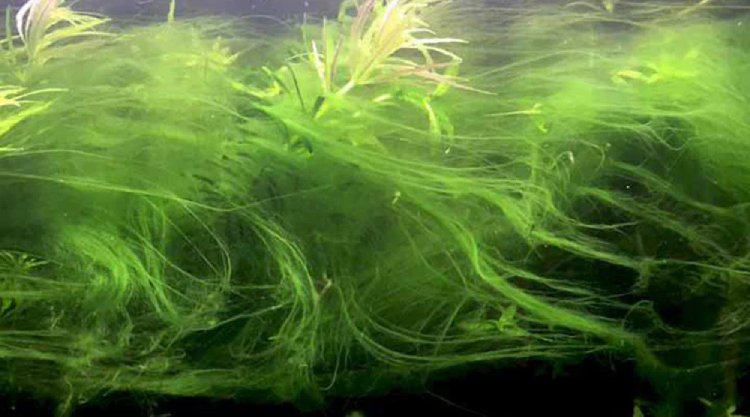
There are several species of filamentous algae that are all lumped together and known as Hair and Thread Algae; instead of growing as a coating along surfaces, they form long chains of unicellular algae that look like flowing green hairs.
These algaes will anchor themselves to plants, decorations and gravel in your aquarium.
Hair and Thread Algae can be very fast growing; one minute, you just see some fuzzy growth on your plant stems, and the next, long stringy clumps of algae are all over the tank.
Common Causes of Hair/Thread Algae
Hair and Thread Algae algae loves high light and high nutrient content.
How to get rid of Hair/Thread Algae
It can be difficult to remove it completely.
Try siphoning it out with your gravel vacuum first. If it’s not firmly attached, you can suck up quite a bit.
You can also manually remove the algae by twisting it around a bottle brush (a tooth brush will kinda work, in a pinch) and pulling it out. You want to wind the strands around the brush, kind of like when you twirl spaghetti noodles on your fork at dinner.
Once you’ve got the bulk of it out of the tank, you can then spot treat with Seachem Excel.
But, make sure to get your lighting under control, or the algae will just grow right back.
Hair/Thread Algae Eaters
- Amano Shrimp
- Cherry Shrimp
- Mollies
- American Flag Fish
10. Staghorn Algae (Compsopogon sp.)
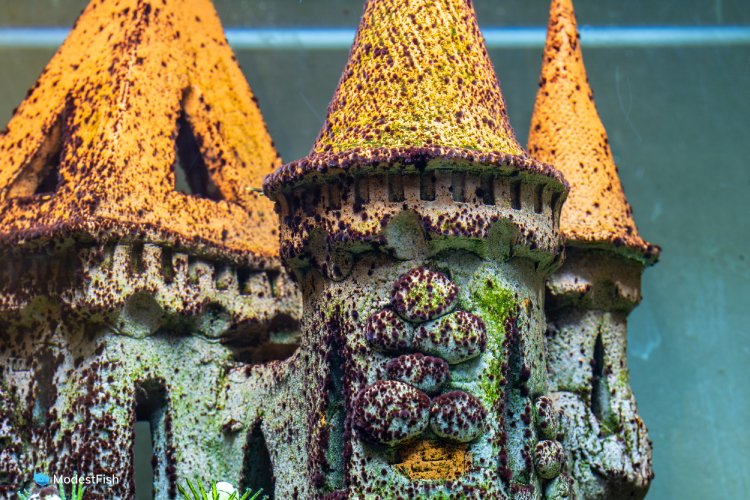
Belonging to the group of red algae, it’s easy to diagnose Staghorn algae.
The growth branches and forks, resembling like the antlers of a stag (hence the name), and will attach themselves to decorations, equipment, and the edges of plant leaves.
Staghorn Algae can be hard to remove manually, and most algae eaters will it. But, Amano shrimp will gladly eat it up.
Amano shrimp grow much larger than cherry or crystal shrimp so they’re strong enough to scrape off staghorn algae and make a meal of it.
Common Causes of Staghorn Algae
High light, low CO2 and/or poor water circulation.
How to get rid of Staghorn Algae
Increase the levels of CO2 in your aquarium and make sure you have good water flow across the whole tank. This will improve plant growth and help them out-compete the algae for resources.
Spot treatment with Seachem Excel is the most effective treatment to get rid of Staghorn Algae.
Temporarily turn off your water circulation and apply the Excel directly to the Staghorn with an eye dropper.
It might take several rounds of treatment, but with some persistence, you can get rid of this stuff for good.
Staghorn Algae Eaters
Most algae eaters don’t find Staghorn Algae appetizing, but luckily, Amanos love it.
- Amano Shrimp
Final Algae Thoughts and Tips
I wish I could provide you with the ultimate formula to get rid of all algae, but there isn’t one.
In closed water systems, every aquarium has its own ecosystem – even if all the parameters are the same. It’s what makes finding the cause of your algae blooms so tricky.
But, I would definitely say that light is the first thing you should take a look at.
Here are some final tips you can use to help prevent algae:
How to Prevent & Control Algae
Control Your Lighting (Avoid Direct Sunlight)
Put your lights on a timer, and maybe even a dimmer. If your lights don’t come with a timer built in, there are many, many options for aftermarket timers that you can add on.
I recommend using LED lights, they are energy efficient, long lasting and economical.
Unstable lighting (8 hours one day then 9 or 10 hours the next etc.), or the wrong intensity can cause algae to thrive and out-perform your plants.
8 hours of light per day is usually enough.
Raise the Competition
Plants compete directly with algae for resources, so by increasing the competition with more plants, or fast growing plants, will reduce the chance for algae to take over.
Keep on top of Water Changes
Perform 25-50% water changes each week. This will help remove excess waste algae could feed on, and will help keep conditions stable.
Test Your Water Source
Tap water will often contain fertilizers like nitrate and phosphate, these will fuel the growth of algae.
Test for these and consider using a phosphate remover, or, use a reverse osmosis system. R/O units will remove all pollutants, leaving you with pure water.
Keep A Clean up Crew
Use algae eaters in your aquarium to help keep algae under control. Here’s a list of excellent algae eaters, just ensure your tanks parameters are suitable before you buy:
- Amano Shrimp
- Otocinclus catfish
- Rosy Barbs
- Cherry Shrimp
- Glass Shrimp
- Bristlenose Plecos
- Black Mollies
- Nerite Snails
Got your own algae stories? Let us know in the comments.

false siamese algae eater (garra cambodgiensis) ate all of my blue green algae, and have never had a problem since. he/she is fully grown, but still tackles all types of algae.
Thank you for your comment! That’s great to know, thank you for sharing your experience with the community.
Great guide! Some images would really help with determining what type of alge a beginner may be up against.
Thank you for your comment! You’re right and I’m currently attempting to source some images.
Thank you for all the time you put into this. I sure wish the internet as it is now existed 30 years ago
After a close reading, I am looking up pictures of the various algae listed. A most informative article.
Thank you for keeping this information up. I have found this to be most helpful in trying to identify the type of algae I am fighting. There are no stores around my location that can help. I am pretty positive I am dealing with Black Beard. I have been fighting this for almost a year! I have tried so many different treatments, changes, new lighting, different substrate after a complete reset. Nothing has helped. Knowing what it is is a great start.